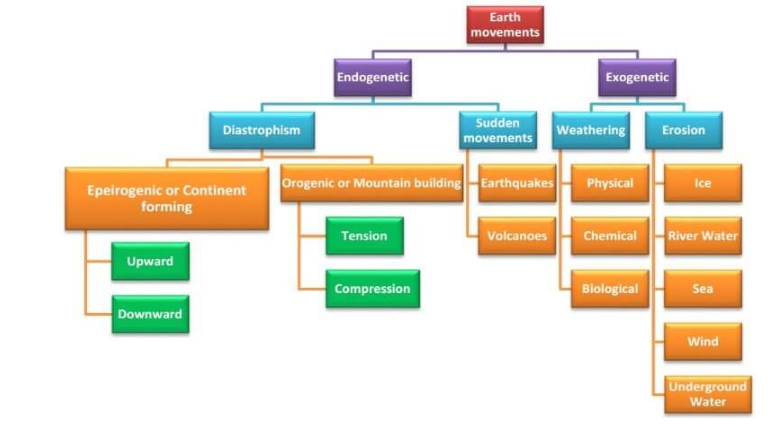Origin-and-evolution-of-universe-solar-system-and-earth / Origin and Evolution of Universe Solar System and Earth / Earth Movements - Endogenetic & Exogenetic
Earth Movements - Endogenetic & Exogenetic
- The Earth's surface is in a constant state of change due to forces originating from both within the Earth (endogenic forces) and external influences (exogenic forces).
- These forces bring about various physical and chemical alterations to the Earth's surface, collectively known as geomorphic processes. These processes can be categorised based on their speed of occurrence.
- Some of these changes happen at an almost imperceptibly slow pace, such as weathering and folding. Others occur more gradually, like erosion, which shapes the landscape over time. In contrast, some changes are sudden and impactful, exemplified by phenomena like earthquakes and volcanic eruptions.
- The term "geomorphic" relates to the form and natural features of the Earth's surface.
- Geomorphic agents, like running water, glaciers, wind, waves, and currents, are mobile mediums that work to remove, transport, and deposit Earth materials. These agents play a crucial role in shaping the landscape.
- Geomorphic processes encompass the physical and chemical transformations that occur on the Earth's surface. These processes result from the interplay of endogenic and exogenic forces and include phenomena such as folding, faulting, weathering, and erosion.
- Geomorphic movements refer to significant-scale changes on the Earth's surface caused by geomorphic processes. These movements alter the landscape through physical and chemical means and are a fundamental aspect of the dynamic nature of the Earth's surface.
ENDOGENETIC GEOMORPHIC MOVEMENTS
- Endogenic geomorphic movements refer to the significant shifts and alterations occurring on the Earth's crust or surface due to forces originating from deep within the Earth (endo: internal; genic: origin; geo: earth; morphic: form). These movements encompass the transformative actions caused by internal forces shaping the Earth's structure and landscape.
- Endogenic geomorphic processes are the set of processes driven by forces originating from the depths of the Earth.
- These processes, such as folding and faulting, are responsible for shaping the Earth's surface, forming mountain ranges, and causing changes through internal forces acting on the crust.
Endogenic movements are categorised into two main types: diastrophic movements and sudden movements.
Diastrophism characterises the gradual deformation and alteration of the Earth's crust. These movements may occur over extended periods, spanning thousands of years.
Sudden movements, such as earthquakes and volcanic eruptions, occur abruptly and over relatively brief time spans.
Within diastrophic movements, two key categories exist:
- Epeirogenic movements encompass changes related to the formation and development of continents. These movements involve subsidence (sinking) and upliftment of land and can occur over prolonged periods.
- Orogenic movements are associated with mountain-building activities, which include folding and faulting processes that create mountain ranges.

EXOGENETIC GEOMORPHIC MOVEMENTS
- Geomorphic processes that shape the Earth's surface, influenced by forces from above the surface like wind and water, are referred to as exogenic geomorphic processes.
- These processes lead to exogenic movements such as weathering and erosion, resulting from external forces acting upon the Earth's surface.
- Most exogenic geomorphic processes create gradual and minor effects. However, over time, these continuous actions have a significant impact on rocks and land due to long-term wear and tear.
DENUDATION
- All the exogenic processes, including weathering and erosion, fall under the general term 'denudation.' This term refers to the action of stripping off or uncovering layers from the Earth's surface.
- Denudation relies on both physical and chemical characteristics of rocks, encompassing factors like folds, faults, bed orientation, joint presence, mineral hardness, and chemical susceptibility to corrosion.
- These elements collectively impact the breakdown and removal of surface materials.
WEATHERING
- Weathering is the breakdown of rocks, soil, and minerals due to physical factors like heat and pressure, as well as chemical elements such as leaching, oxidation, reduction, and hydration.
- It's considered an in-situ or on-site process because it doesn't involve significant movement of materials. Weathering causes materials to break down right where they are. Once materials are weathered, erosion carries them away.
- There are three primary categories of weathering processes: chemical, physical (mechanical), and biological. These types of weathering often work together, collectively influencing the breakdown of materials.

